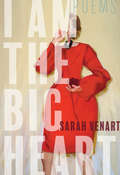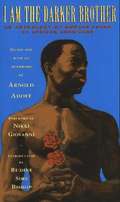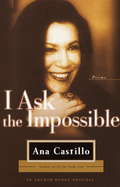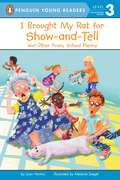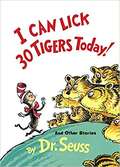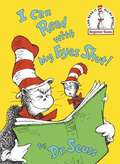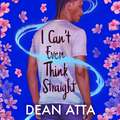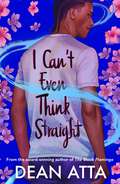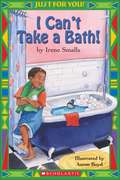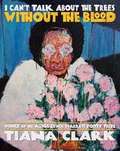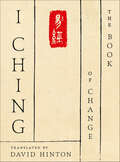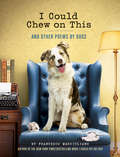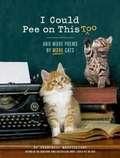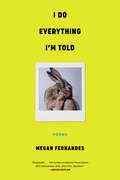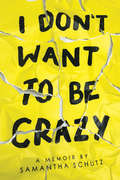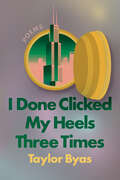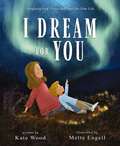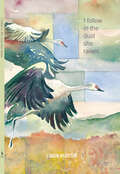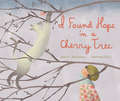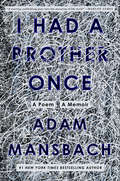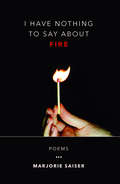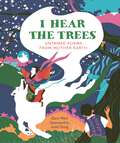- Table View
- List View
I Am the Big Heart
by Sarah VenartA love story to the emotional self—this heart is tender, but it also has a savage bite. What does it mean to be the big heart? Or to hope to be the big heart? Or to fail to be that big heart? How far can a heart stretch? How does being a parent stretch it further? How does a heart manage under the pressure of children, of self, of hospital technician, of partner, of death? In this collection, big heartedness is both demand and desire. It emerges from family life—the kid who says to your face that she prefers her other parent; the father monkeying around in the art gallery; the mother who “gets on with it” in silence; the husband, distant and intimate under the marriage yoke. There is also in this collection the stirring of wilder desires than family is supposed to nurture, feelings more fiercely self-assertive than a parent—a mother particularly—is supposed to admit. This collection asks how to rise to the occasions that family presents and also how to let oneself spill over the bounds of familial roles. Venart’s poems reach into the past but don’t get lost there; they look the present in the face—they have to: the clock is ticking, the children calling, there are hot dogs to be sliced and the dog won’t walk itself. The title is ironic. And also kind of secretly stoically hoping that it's not ironic. But it is: …And now everyone is arrowarrow, arrows. Everyone harpoons.And I am the big heart, aren’t I?When my black dog was being put down, in her lastsecond I whispered, Squirrel. (from “Epiphany”)
I Am the Darker Brother: An Anthology of Modern Poems by African Americans (Revised Edition)
by Arnold AdoffThis is an eclectic and wonderful collection of poems for young adults followed by short biographies of the authors and poems. Also includes an index of authors, titles, and first lines.
I Ask the Impossible
by Ana CastilloAn Anchor Books OriginalCherished for her passionate fiction and exuberant essays, the author hailed by Julia Alvarez as ?una storyteller de primera,? and by Barbara Kingsolver in The Los Angeles Times as ?impossible to resist,? returns to her first love?poetry?to reveal an unwavering commitment to social justice, and a fervent embrace of the sensual world.With the poems in I Ask the Impossible, Castillo celebrates the strength that "is a woman?buried deep in [her] heart." Whether memorializing real-life heroines who have risked their lives for humanity, spinning a lighthearted tale for her young son, or penning odes to mortals, gods, goddesses, Castillo?s poems are eloquent and rich with insight. She shares over twelve years of poetic inspiration, from her days as a writer who ?once wrote poems in a basement with no heat," through the tenderness of motherhood and bitterness of loss, to the strength of love itself, which can ?make the impossible a simple act." Radiant with keen perception, wit, and urgency, sometimes erotic, often funny, this inspiring collection sounds the unmistakable voice of a "woman on fire? / and more worthy than stone."From the Trade Paperback edition.
I Brought My Rat for Show-and-Tell: And Other Funny School Poems (Penguin Young Readers, Level 3)
by Joan HortonYou don't bring your rat to show-and-tell. You do mouth off to the class bully, but only when you're safe at home in bed. These are just some of the lessons to be learned in this hilarious collection of school poems-guaranteed to tickle any kid's funny bone!
I Can Lick 30 Tigers Today! And Other Stories
by Dr SeussThe Cat in the Hat tells us three zany stories-in-verse about his son, his daughter, and his great-great-grandfather.
I Can Read with My Eyes Shut!
by Dr SeussThe Cat in the Hat takes Young Cat in tow to show him the fun he can get out of reading.
I Can't Even Think Straight: A queer coming of age story
by Dean AttaBig decisions and messy relationships. It's all part of life for Kai. A must-read queer coming of age story for fans of Sarah Crossan and Sex Education, written in verse by Stonewall-Award-winning, Carnegie-shortlisted author Dean Atta.Kai is going into a new school year with some big decisions to make: when to come out as gay, what he wants to do in life and who he wants to date. Is it any wonder he can't think straight? Best friends Matt and Kai made a promise to each other to stay in the closet. Matt isn't ready to come out, but Kai wants nothing more than to write his own story. He decides it's time to break his promise and show his true self to the world.Now out and proud, Kai starts dating super-hot Obi, but it's far from smooth sailing. Is love closer to home than Kai realises?
I Can't Even Think Straight: A queer coming of age story
by Dean AttaBig decisions and messy relationships. It's all part of life for Kai. A must-read queer coming of age story for fans of Sarah Crossan and Sex Education, written in verse by Stonewall-Award-winning, Carnegie-shortlisted author Dean Atta.Kai is going into a new school year with some big decisions to make: when to come out as gay, what he wants to do in life and who he wants to date. Is it any wonder he can't think straight? Best friends Matt and Kai made a promise to each other to stay in the closet. Matt isn't ready to come out, but Kai wants nothing more than to write his own story. He decides it's time to break his promise and show his true self to the world.Now out and proud, Kai starts dating super-hot Obi, but it's far from smooth sailing. Is love closer to home than Kai realises?
I Can't Take a Bath!
by Irene SmallsA monster in the bathtub? A really bad headache? Some people will say anything to keep from taking a bath!
I Can't Talk About the Trees Without the Blood (Pitt Poetry Ser.)
by Tiana ClarkWinner of the 2017 Agnes Lynch Starrett Poetry Prize <P<P> For prize-winning poet Tiana Clark, trees will never be just trees. They will also and always be a row of gallows from which Black bodies once swung. This is an image that she cannot escape, but one that she has learned to lean into as she delves into personal and public histories, explicating memories and muses around race, elegy, family, and faith by making and breaking forms as well as probing mythology, literary history, her own ancestry, and, yes, even Rihanna. I Can’t Talk About the Trees without the Blood, because Tiana cannot engage with the physical and psychic landscape of the South without seeing the braided trauma of the broken past—she will always see blood on the leaves.
I Ching: The Book of Change
by David HintonA master translator's beautiful and accessible rendering of the seminal Chinese textIn a radically new translation and interpretation of the I Ching, David Hinton strips this ancient Chinese masterwork of the usual apparatus and discovers a deeply poetic and philosophical text. Teasing out an elegant vision of the cosmos as ever-changing yet harmonious, Hinton reveals the seed from which Chinese philosophy, poetry, and painting grew. Although it was and is widely used for divination, the I Ching is also a book of poetic philosophy, deeply valued by artists and intellectuals, and Hinton's translation restores it to its original lyrical form.Previous translations have rendered the I Ching as a divination text full of arcane language and extensive commentary. Though informative, these versions rarely hint at the work's philosophical heart, let alone its literary beauty. Here, Hinton translates only the original strata of the text, revealing a fully formed work of literature in its own right. The result is full of wild imagery, fables, aphorisms, and stories. Acclaimed for the eloquence of his many translations of ancient Chinese poetry and philosophy, Hinton has reinvented the I Ching as an exciting contemporary text at once primal and postmodern.
I Confess
by Eric SchmaltzHow is a lyric poem like a polygraph machine? A personal, poetic examination of the technology of truth-telling.Eric Schmaltz’s I Confess delves into the complexities of truth-telling in poetry, and the history of technologies designed to produce truth from willing and unwilling subjects, considering what it means to use a device – poetry or polygraph – to draw out one’s most profound feelings and emotions.Exploring the intersection of power, technology, and language, I Confess meditates on lie detection and its history, including trials by ordeal and pseudoscientific technologies. The poet then turns to his own personal experiences working with a lie detector and polygraph analyst. Taking himself as the central subject of the book, Schmaltz puts his subjectivity and positionality under scrutiny.The answers to questions such as What does family mean to you? and Can you describe a time when you felt your best? inspire a range of forms from conventional lyrical verse to list poems to palindromes to visual poems. With an afterword by Orchid Tierney, I Confess is a personal, poetic document of truth’s performance under duress.
I Could Chew on This: And Other Poems by Dogs
by Francesco MarciulianoA New York Times bestseller? Oh, you know the dogs weren't going to let the cats get away with that! This canine companion to I Could Pee on This, the beloved volume of poems by cats, I Could Chew on This will have dog lovers laughing out loud. Doggie laureates not only chew on quite a lot of things, they also reveal their creativity, their hidden motives, and their eternal (and sometimes misguided) effervescence through such musings as "I Dropped a Ball," "I Lose My Mind When You Leave the House," and "Can You Smell That?" Accompanied throughout by portraits of the canine poets in all their magnificence, I Could Chew on This is a work of unbridled enthusiasm, insatiable appetite, and, yes, creative genius.
I Could Chew on This: And Other Poems by Dogs
by Francesco MarciulianoA New York Times bestseller? Oh, you know the dogs weren't going to let the cats get away with that! This canine companion to I Could Pee on This, the beloved volume of poems by cats, I Could Chew on This will have dog lovers laughing out loud. Doggie laureates not only chew on quite a lot of things, they also reveal their creativity, their hidden motives, and their eternal (and sometimes misguided) effervescence through such musings as "I Dropped a Ball," "I Lose My Mind When You Leave the House," and "Can You Smell That?" Accompanied throughout by portraits of the canine poets in all their magnificence, I Could Chew on This is a work of unbridled enthusiasm, insatiable appetite, and, yes, creative genius. Plus, this is a fixed-format version of the book, which looks nearly identical to the print version.
I Could Pee on This, Too: And More Poems by More Cats
by Francesco MarciulianoThere's a new cat in town! This feisty sibling of the international bestseller I Could Pee on This will be making its own sensational mark in the cat-poetry world. I Could Pee on This, Too explores fresh feline emotions and philosophical musings through cats' own poetry, such as "Welcome New Cat," "Sleeping My Life Away," and "You Also Live Here." Any cat lover who's longed for a deeper look into the enigmatic world of their cats will fall whiskers over paws for this well-versed follow-up.
I Do Everything I'm Told
by Megan FernandesNamed a Best Book of the Season by Vogue and Vulture. “In the absence of love, ritual. / Understand that ritual is a kind of patience, an awaiting and waiting. Keep / waiting, kitten. You will be surprised what you can come back from.” Restless, contradictory, and witty, Megan Fernandes’ I Do Everything I’m Told explores disobedience and worship, longing and possessiveness, and nights of wandering cities. Its poems span thousands of miles, as a masterful crown of sonnets starts in Shanghai, then moves through Brooklyn, Los Angeles, Lisbon, Palermo, Paris, and Philadelphia—with a speaker who travels solo, adventures with strangers, struggles with the parameters of sexuality, and speculates on desire. Across four sections, poems navigate the terrain of queer, normative, and ambiguous intimacies with a frank intelligence: “It’s better to be illegible, sometimes. Then they can’t govern you.” Strangers, ancestors, priests, ghosts, the inner child, sisters, misfit raccoons, Rimbaud, and Rilke populate the pages. Beloveds are unnamed, and unrealized desires are grieved as actual losses. The poems are grounded in real cities, but also in a surrealist past or an impossible future, in cliché love stories made weird, in ordinary routines made divine, and in the cosmos itself, sitting on Saturn’s rings looking back at Earth. When things go wrong, Fernandes treats loss with a sacred irreverence: “Contradictions are a sign we are from god. We fall. We don’t always get to ask why.”
I Don't Want to Be Crazy
by Samantha SchutzA harrowing, remarkable poetry memoir about one girl's struggle with anxiety disorder.A harrowing, remarkable poetry memoir about one girl's struggle with anxiety disorder.This is a true story of growing up, breaking down, and coming to grips with a psychological disorder. When Samantha Schutz first left home for college, she was excited by the possibilities -- freedom from parents, freedom from a boyfriend who was reckless with her affections, freedom from the person she was supposed to be. At first, she revelled in the independence. . . but as pressures increased, she began to suffer anxiety attacks that would leave her mentally shaken and physically incapacitated. Thus began a hard road of discovery and coping, powerfully rendered in this poetry memoir.
I Done Clicked My Heels Three Times: Poems
by Taylor ByasInspired by The Wiz, this debut, full-length poetry collection celebrates South Side Chicago and a Black woman&’s quest for self-discovery—one that pulls her away from the safety of home and into her powerI Done Clicked My Heels Three Times takes its inspiration and concept from the cult classic film The Wiz to explore a Black woman&’s journey out of the South Side of Chicago and into adulthood. The narrative arc of The Wiz—a tumultuous departure from home, trials designed to reveal new things about the self, and the eventual return home—serves as a loose trajectory for this collection, pulling readers through an abandoned barn, a Wendy's drive-thru, a Beyoncé video, Grandma's house, Sunday service, and the corner store. At every stop, the speaker is made to confront her womanhood, her sexuality, the visibility of her body, alcoholism in her family, and various ways in which narratives are imposed on her.Subverting monolithic ideas about the South Side of Chicago, and re-casting the city as a living, breathing entity, I Done Clicked My Heels Three Times spans sestinas, sonnets, free-verse, and erasures, all to reimagine the concept of home. Chicago isn&’t just a city, but a teacher, a lingering shadow, a way of seeing the world.
I Dream for You: Imagining God’s Love and Plans for Your Life
by Kate WoodA mother&’s dreams for her child begin before they are born and continue as they grow and discover dreams of their own. From Kate Wood, the writer of the award-winning Wood and Spoon blog and author of Her Daily Bread comes this beautiful picture book about a mother&’s love, God's plans, and the vast potential in every child.An expectant mother&’s mind is filled with many questions: When will my child arrive? What will they look like? What will they feel like in my arms??But on the day the child arrives, those hopes grow and change from dreams of them into dreams for them. Who will they become? What will they be passionate about? What kind of mark will they leave on this world?I Dream for You celebrates the wonderful possibilities of all those dreams and the comforting security of God&’s plan for their life, and: Reminds children how much God loves themIncludes Scripture references for each pageIs great for parents and grandparents reading aloud to their childrenIs perfect for new baby gifts, shower gift, baptism gifts, birthday gifts, and more.
I Follow in the Dust She Raises (The Alaska Literary Series)
by Linda MartinI Follow in the Dust She Raises is a collection of deeply personal poems born from a life sharply observed. Martin takes readers from the mountains of the West to the shores of Alaska, as she delves into the rippling depth of childhood experiences, tracks the moments that change a life, and settles into the fine grooves of age. Exploring the ties of family and grief, Martin’s unflinching poetry ripples with moments of extraordinary beauty plucked from what seem like ordinary lives.
I Found Hope in a Cherry Tree
by Jean E. PendziwolJean E. Pendziwol’s newest picture book is a lyrical meditation on nature and hope. The child in this story observes the sun by playing with her shadow, though sometimes it disappears. She listens to the wind tell stories, even when it howls like wolves. She tastes snowflakes — sometimes sweet and delicate; other times sharp on her cheeks. And finally, she finds hope in the buds on a cherry tree that survive through the winter to blossom in spring. Jean E. Pendziwol has written a layered, lyrical exploration of the hardships and beauties of nature. Her poem, beautifully illustrated by Nathalie Dion, is a study in contrasts and a message of the hope that carries us through the year and through our lives. Correlates to the Common Core State Standards in English Language Arts: CCSS.ELA-LITERACY.RL.1.2 Retell stories, including key details, and demonstrate understanding of their central message or lesson. CCSS.ELA-LITERACY.RL.1.4 Identify words and phrases in stories or poems that suggest feelings or appeal to the senses.
I Had a Brother Once: A Poem, A Memoir
by Adam MansbachA brilliant, genre-defying work—both memoir and epic poem—about the struggle for wisdom, grace, and ritual in the face of unspeakable loss&“A bruised and brave love letter from a brother right here to a brother now gone . . . a soaring, unblinking gaze into the meaning of life itself.&”—Marlon James, author of Black Leopard, Red Wolfmy father saiddavid has taken his own lifeAdam is in the middle of his own busy life, and approaching a career high in the form of a #1 New York Times bestselling book—when these words from his father open a chasm beneath his feet. I Had a Brother Once is the story of everything that comes after. In the shadow of David&’s inexplicable death, Adam is forced to re-remember a brother he thought he knew and to reckon with a ghost, confronting his unsettled family history, his distant relationship with tradition and faith, and his desperate need to understand an event that always slides just out of his grasp. This is an expansive and deeply thoughtful poetic meditation on loss and a raw, darkly funny, human story of trying to create a ritual—of remembrance, mourning, forgiveness, and acceptance—where once there was a life.
I Have Nothing to Say about Fire
by Marjorie Saiser2017 Nebraska Book Award This new collection by Nebraska poet Marjorie Saiser explores the notion of witnessing. Particularly in our technological age, when we have access to international news as it happens, the question comes up: what responsibility do individuals—including those living in relatively quiet middle America—have in regard to world events? The poems in I Have Nothing to Say about Fire reference autobiographical elements: marriage, children, parents, in-laws, etc., but they also reference global tragedy: war, terrorism, genocide. As we experience our own personal losses and triumphs, what relationships should we strive for with family, friends, neighbors, and the strangers around us, particularly as their narratives push them forward into our and/or the public’s consciousness? In this book, Marjorie Saiser explores these essential questions and offers potential answers that may help all of us.
I Hear The Trees
by Zaro WeilJourney into the wild world of Mother Earth in this enchanting poetry collection, beautifully illustrated by Junli Song. Sigh as a mother wolf teaches her cub how to howl. Laugh with bamboozled berries and a ruby-wonderful beet. Feel the thrill of Tyranno's terrifying tale and play with ten on-the-run haiku mice.Your imagination will soar as a hullabaloo of creatures and plants, moon, sun and stars make their way word by word and picture by fantastical picture into your heart.
